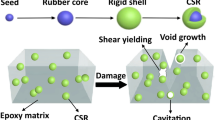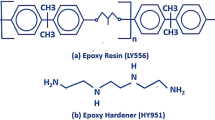Abstract
Nanocomposites based on ED-20 epoxy resin and single-walled carbon nanotubes (SWCNT) with high aspect ratios (l/d ~ 2500) have been produced. The filler has been introduced into a matrix using a high speed mixer without solvents. The electrical and physical characteristics of produced composites have been examined at various SWCNT concentrations. A low percolation threshold is experimentally established, indicating weak filler agglomerates in the epoxy matrix. The dielectric permittivity and tangent loss are plotted as the functions of the SWCNT concentration within a wide frequency range. All dependences exhibit the presence of a relaxation peak shifting toward the higher frequencies as the filler concentration increases. The investigation of nanocomposite cleavages via scanning electron microscopy reveals a uniform SWCNT distribution in the matrix.



Similar content being viewed by others
REFERENCES
Mittal, V., Polymer Nanotube Nanocomposites: Synthesis, Properties, and Applications, New York: Wiley, 2010.
Rakov, E.G., Carbon nanotubes in new materials, Russ. Chem. Rev., 2013, vol. 82, no. 1, pp. 27–47.
Irzhak, V.I., Epoxide composite materials with carbon nanotubes, Russ. Chem. Rev., 2011, vol. 80, no. 8, pp. 787–806.
Yurkov, G.Yu. and Kondrashov, S.V., Nanocomposites based on high-density polyethylene and cobalt nanoparticles: synthesis, structure and properties, Aviats. Mater. Tekhnol., 2014, suppl. 2, pp. 29–33.
Eletskii, A.V., Knizhnik, A.A., Potapkin, B.V., and Kenny, J.M., Electrical characteristics of carbon nanotube-doped composites, Phys.-Usp., 2015, vol. 58, no. 3, pp. 209–251.
Feng, C. and Jiang, L., Micromechanics modeling of the electrical conductivity of carbon nanotube (CNT)–polymer nanocomposites, Composites, Part A, 2013, vol. 47, pp. 143–149.
Dyre, J.C. and Schrøder, T.B., Hopping models and ac universality, Phys. Status Solidi B, 2002, vol. 230, no. 1, pp. 5–13.
Psarras, G.C., Manolakaki, E., and Tsangaris, G.M., Electrical relaxations in polymeric particulate composites of epoxy resin and metal particles, Composites, Part A, 2002, vol. 33, pp. 375–384.
Thostenson, E., Li C., and Chou, T., Nanocomposites in context, Compos. Sci. Technol., 2005, vol. 65, nos. 3–4, pp. 491–516.
Funding
This work was supported by the Federal Agency for Scientific Organizations of Russia within the framework of the State task (project no. 45.11).
Author information
Authors and Affiliations
Corresponding author
Additional information
Translated by O. Maslova
Rights and permissions
About this article
Cite this article
Klyuev, I.Y., Shevchenko, V.G., Kuperman, A.M. et al. Electrophysical Characteristics of Epoxy Nanocomposites with Ultralow Percolation Thresholds. Inorg. Mater. Appl. Res. 11, 416–419 (2020). https://doi.org/10.1134/S2075113320020197
Received:
Revised:
Accepted:
Published:
Issue Date:
DOI: https://doi.org/10.1134/S2075113320020197




